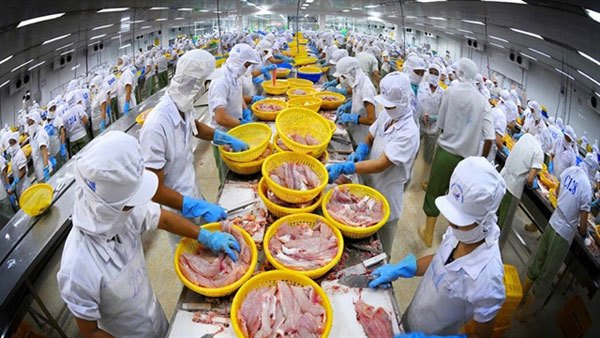 |
| Vietnam’s seafood exports this year are expected to be worth US$9.4 billion in all, an increase of 10 per cent from 2020. — Photo tapchitaichinh.vn |
It was exported by the Minh Phu Seafood Corporation in the Cuu Long (Mekong) Delta province of Hau Giang.
A spokesman for the company said its exports could grow by 10 per cent in volume this year but turnover and profit are likely to remain the same as last year.
Vietnam’s seafood exports this year are expected to be worth US$9.4 billion in all, an increase of 10 per cent from 2020.
Deputy Minister of Agriculture and Rural Development Phung Duc Tien said shrimp, tra fish and frozen fisheries would remain the key items this year.
Shrimp exports are expected to increase by 15 per cent to $4.4 billion, and tra fish shipments are likely to recover significantly and increase by around 5 per cent to $1.6 billion.
Truong Dinh Hoe, general secretary of the Vietnam Association of Seafood Exporters and Producers (VASEP), said to realise those targets seafood companies are making great efforts to overcome the challenges posed by the COVID-19 pandemic.
Knowing that the pandemic would not end overnight, Vietnamese fisheries companies are learning to live with it, he added.
For instance, Minh Phu has been badly affected since restaurants-hotels abroad used to be its major customer segment, while the later have been closed for nearly a year due to the COVID-19 pandemic.
But household consumers still have high demand - if anything, higher than usual since they cannot eat out - for products like seafood.
The company’s seafood sells well in supermarkets in other countries, and so this year it will tweak its export strategy to focus on retail channels such as supermarkets and shops.
To meet the household demand, its deputy director Le Van Diep said, the company would switch its exports from large-sized shrimp to smaller ones.
Many experts approved of this strategy saying small shrimps ranging in size from 50 to even 120 counts per kilo are becoming popular since they lend themselves to many value-added shrimp products. “It is easier for consumers to make dishes with small shrimps,” they explained.
The chairman of Sao Ta Foods Joint Stock Company, Ho Quoc Luc, said with the pandemic yet to be controlled around the world his company is exploring various options amid the challenges.
It is focusing more on retail channels than restaurants and hotels and has changed packaging of processed products to reduce costs and thus prices, he said.
Besides switching their focus to retail channels, Vietnamese seafood companies have also identified some key export markets like the EU, the US and Japan, especially the EU to tap tax preferences under the EU-Vietnam Free Trade Agreement (EVFTA).
Besides the EU, Norway is also considered a promising market for shrimp and tuna exports as are the UK, Switzerland, Russia, North America, Hongkong, Australia, and Canada.
Hoe said a seafood export boom began after the EVFTA took effect in August 2020, with exports to the EU surging.
Earlier, in the seven months before the trade deal took effect, Vietnam’s seafood shipments to the EU fell by 26 per cent year-on-year because of the pandemic.
But the tax cuts under the deal have been a catalyst, Hoe said.
Analysts said the seafood industry has capitalised on opportunities arising also from other new-generation FTAs such as the Regional Comprehensive Economic Partnership, and most recently the UK-Vietnam FTA.
Analysts at BIDV Securities Joint Stock Company said the EVFTA would create large differences in tariffs between Vietnamese tra fish (pangasius) and those from rival countries.
The EU will eliminate tariffs on Vietnamese tra fish in the next three years as EVFTA commitments are fully implemented, while imports from countries like China and Indonesia will continue to be taxed at 4.5-9 per cent.
Another advantage Vietnamese seafood enterprises enjoy is the country’s effective control of the pandemic, which has in fact been beneficial for all companies.
But experts also listed some hurdles the fisheries sector could face this year.
For instance, in the Japanese market, Vietnamese shrimp exporters have to compete hard with their Indian counterparts, who have lower production costs, though Vietnam has an FTA with Japan.
The anti-dumping taxes on shrimp and tra fish in the US show no signs of ending in the next five years.
The IUU yellow card, which has not been lifted, also affects Vietnam’s seafood exports.
To overcome these, the Government, the seafood industry and companies have to improve quality, closely control origin and production process and meet labour and environmental standards, experts said.
2021 to be a difficult year for consumer credit: analysts
Nguyen Ngoc Hanh of HCM City’s Tan Binh District said before COVID-19 broke out she liked to use instalment plans for buying household gadgets.
“At that time it was always easy to buy even expensive items on instalments with zero interest since many financial companies like ACS, Home Credit and FE Credit were ready to lend.
“But now I don’t dare to buy many items even on instalments any longer because my family’s income has decreased significantly due to the pandemic and we have to cut costs.”
Many people across the country are in a similar situation since the outbreak has affected most sectors and people’s incomes.
For their part, finance companies and banks are forced to be more discreet in lending.
As a result analysts fear the consumer finance market will find it difficult to match the growth it achieved in recent years.
Nguyen Canh Vinh, acting general director of Eximbank, said since the beginning of 2020, when COVID-19 first broke out, his bank has had to carefully control lending, especially to the property sector.
The stringent credit approval process would continue this year, he said.
Nguyen Dinh Tung, the general director of Orient Commercial Joint Stock Bank (OCB), said his bank would stick to its policy of closely controlling credit quality, especially consumer credit, to minimise risks.
Analysts said it is this caution on the part of banks that would prevent consumer finance from growing much this year.
But despite their caution, banks and finance companies do not want to give up the highly profitable consumer lending and still offer promotions to attract customers.
They include Vietcombank, ACB, VIB, Namabank, Viet Capital Bank, and HDBank.
But they admitted that despite the attractive offers, the consumer finance market would not grow strongly this year since demand is not high since people are tightening their belts and cutting expenses due to the pandemic.
Nguyen Hoang Minh, deputy director of the State Bank of Vietnam’s HCM City branch, said in 2020 the consumer lending segment saw modest growth but increasing signs of bad debts, especially at finance companies.
According to VPBank’s results for 2020, its subsidiary FE Credit’s pre-tax profit was down 16.3 per cent at VND3.71 trillion (US$159.2 million).
Due to impacts of the pandemic, many customers were unable to repay their loans on schedule and FE Credit had to roll over or restructure loans and reduce or waive interest for 250,000 customers.
Nevertheless, analysts were in doubt about the long-term prospects for the consumer finance market in a country with a population of nearly 100 million, a growing middle class and rising consumption. VNS

Vietnam promotes export of processed agro-forestry-fisheries products
The project aims at improving the quality and value of agro-exports to meet the regulations of importers.

Vietnam strives to be world leader in seafood production and exports
The nation is poised to become a deep seafood processing centre and join the group made up of the three leading seafood producing and exporting countries in the world,